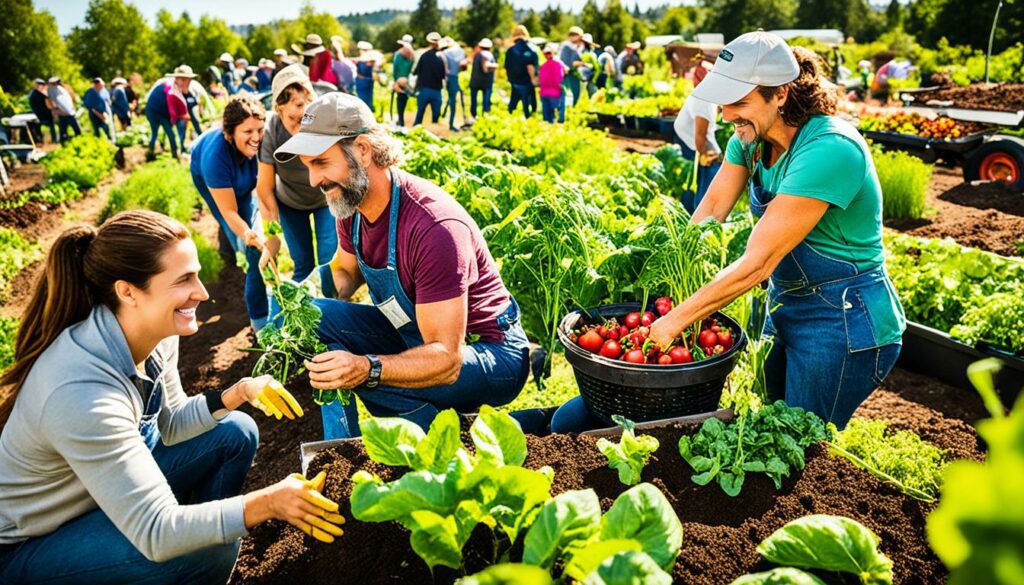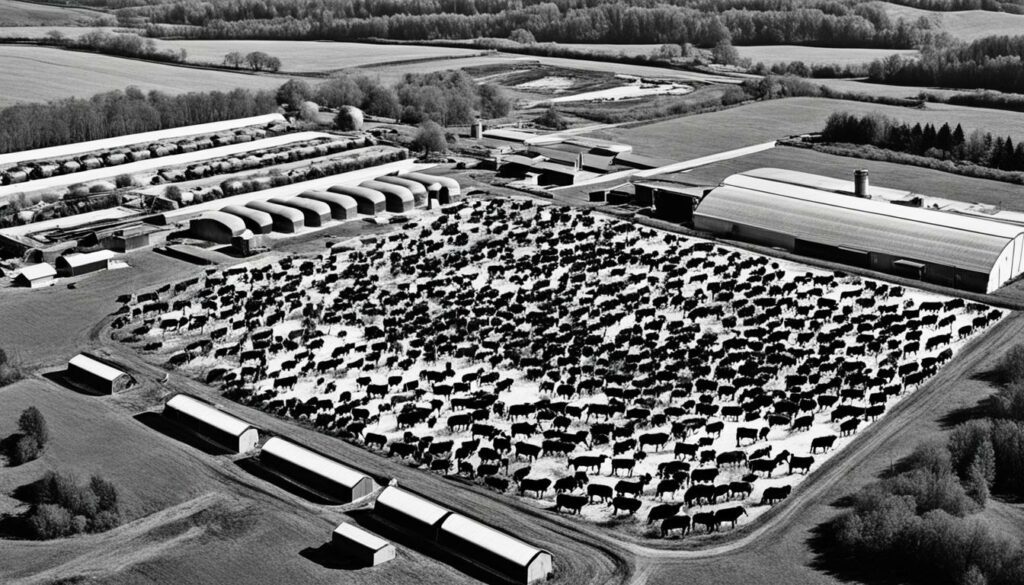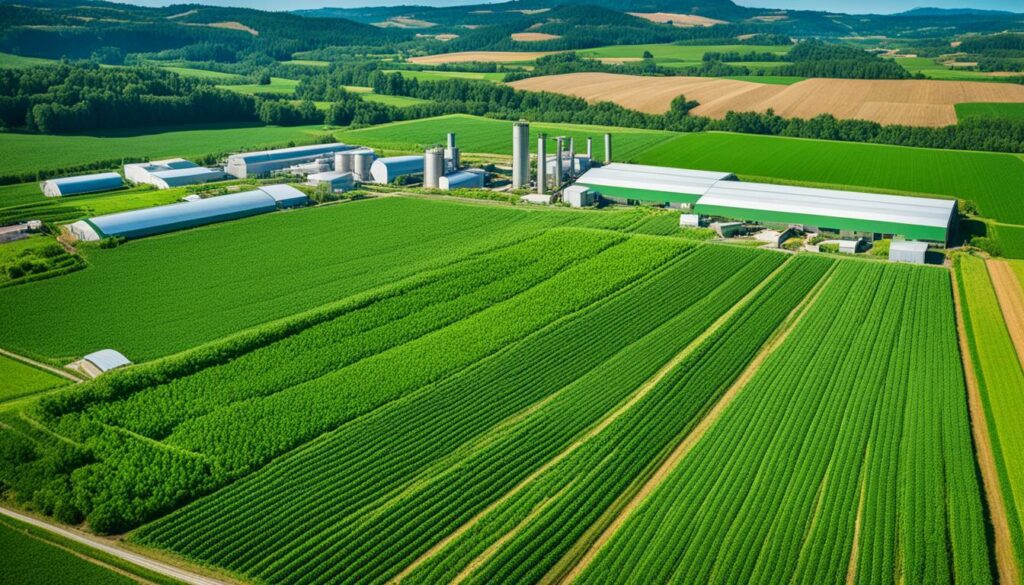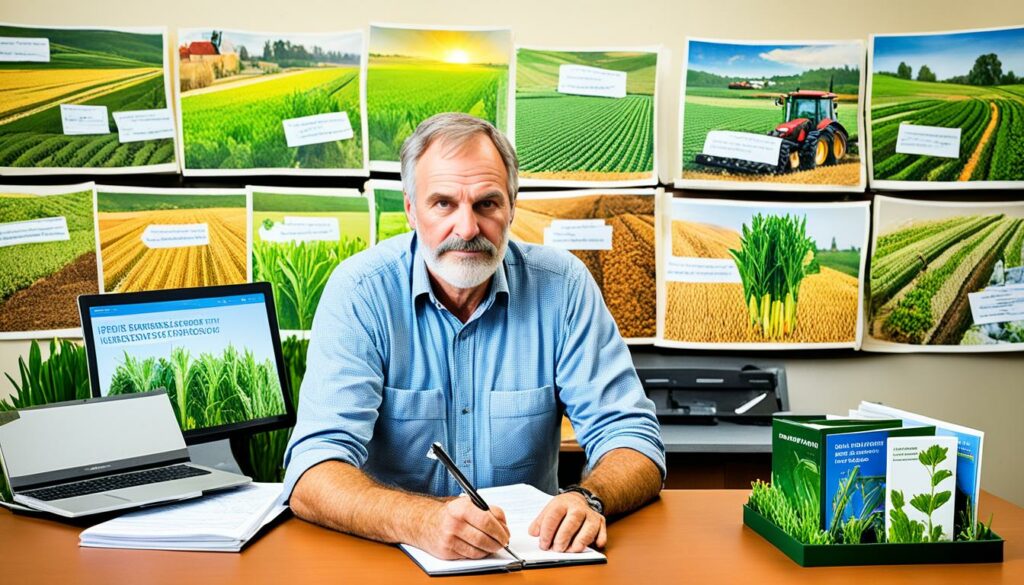Menu

Did you know that the AAA once limited how much produce farmers could grow? It aimed to boost crop prices by cutting supply. However, this plan backfired, increasing prices for consumers. In the 1970s, efforts to improve farming through policies like the Green Revolution led to too much being grown. This imbalance messed up the supply and demand situation.
The Food Security Act of 1985 and the 2002 Farm Security Act brought changes. They offered help to farmers through incentives and subsidies. But, these mainly supported the growth of animal feed and crops like corn for meat. This focus on certain crops kept the cycle of surplus going. The COVID-19 pandemic made things worse. It caused a surplus in fruits and vegetables, leading to initiatives like The Farmlink Project to stop food from going to waste.
President Biden’s new farm policy plans offer hope for big changes. He wants to help small and minority-owned farms do well. Support will go to growing healthy crops that are good for the planet. These ideas fit with the big goals of the Agricultural Innovation Agenda (AIA). The AIA dreams of a 40% boost in farming production in the US by 2050. Plus, it wants to cut down on the harm agriculture does to the environment by half.
The USDA is key in pushing agricultural innovation forward. It helps farmers and the environment. The USDA gives farmers new laws and supports for green farming. This way, farmers can work smarter and help the planet. It’s all about doing more, but in a way that keeps the earth healthy.
The USDA started the Agricultural Innovation Agenda (AIA) to bring fresh ideas to farming. This plan helps farmers stay on top globally. It also makes sure they use energy wisely. The aim is to help farmers grow their crops using the latest green technologies.
The USDA wants to grow more food, up to 40% more by 2050. This big plan looks 30 years ahead. It’s about finding new ways to farm better. This includes smart farming laws and the latest tech.
The goal is to farm more but without harming nature. The 2021 Agricultural Outlook Forum talked a lot about this. They want to farm better while keeping the Earth clean and healthy.
The USDA aims to cut how much farming hurts the planet by half, by 2050. They are working on green farming and using earth-friendly energy. This big project helps lower pollution and save the Earth.
They also keep an eye on how well farmers protect nature. This way, they can cheer on progress and keep getting better at helping the Earth.
The USDA is serious about farming in a way that’s good for the future. They support new technologies and greener farming. This helps American farming stay strong and safe for our planet.
| USDA Goals | Initiatives |
|---|---|
| Increase agricultural production by 40% by 2050 | Innovative programmes, National Biotechnology and Biomanufacturing Initiative |
| Reduce environmental footprint by 50% by 2050 | Environmental subsidies, sustainable agriculture incentives |
| Enhance carbon sequestration and water quality | Tracking conservation practices, supporting renewable energy |
The USDA sees how vital local communities are for agricultural growth. So, it started rural development schemes. These plans join government support with local farming efforts. They aim to make local food systems stronger and ensure food safety. The USDA’s Centre for Faith-Based and Neighbourhood Partnerships helps many non-profits work together for the community’s good.

This centre shows the USDA’s drive to bring different groups together. It works with both religious and non-religious groups to improve local farming. The aim is to connect farmers and local people better. This way, programs like Feds Feed Families can help community food projects by bringing resources and volunteers together.
Helping rural areas grow is key for farming to keep going strong. The USDA supports smaller farms, many that sell directly to people. It’s really important because only a small part of US farming focuses on local food.
The USDA also works with GusNIP to encourage local food buying. In GusNIP’s third year, it made an $85 million difference. This is way more than before, showing how important such projects are. They help rural areas and push for farming to be more sustainable.
“As community agricultural models continue to grow, they integrate regenerative agriculture practices including crop diversification, companion planting, and native plant species utilisation, ensuring sustainable production and resilience.”
Getting involved with local farming doesn’t just help the economy. It also makes Americans healthier and more secure about their food. It encourages better eating habits and makes communities stronger. This is good for everyone living in rural places.
The USDA is working on improving meat and poultry supply chains. The Biden-Harris Administration has put $1 billion into this. It’s to help small and midsized processors become stronger.
They are also offering grants up to $125 million. These aim to make sure everyone has a fair chance. The USDA is working with 30 businesses to make things better since 2021.
One step is the Local Meat Capacity Grant Program. They’ve set aside $75 million for this. It’s for making processing better with new equipment and more space. Both large and small projects can apply. They can also apply for the Indigenous Animals Grant, which gives $50 million to improve indigenous ways of processing meat. This grant is open for applications until July 19, 2023.
To improve supply chains, the USDA is also helping with loans. More than $750 million has been guaranteed for food infrastructure. Another $167 million has gone to support meat and poultry lending. The USDA has even given $15 million for worker training.
Governor Tony Evers has given $10 million to help Wisconsin’s meat processors. This has helped 91 processors and supports both small and big farms. This work ensures farmers benefit across the state.
The USDA’s ongoing work is vital. It focuses on fair trade in agriculture. With grants and new technology, the changes aim to help farmers in the long term.
The National Biotechnology and Biomanufacturing Initiative aims to put the US ahead in biotechnology. It focuses on boosting agricultural science advancement and biomanufacturing research. This means stronger scientific backgrounds and new genetic engineering skills. The USDA is leading to help American farmers.

The initiative works on top-notch biotechnology and biomanufacturing research. The COVID-19 crisis showed how important this research is for health. It helped create tests, medicines, and vaccines.
Its goals include improving safety and setting better rules. It also looks at how to measure progress and grow the bioeconomy. Boosting markets for bioenergy and biobased goods is key to helping the economy.
Boosting global agriculture competition is important. Using scientific help, the USDA is making American farmers more competitive worldwide. They want to better local biomanufacturing and train a varied workforce in biotechnology.
This initiative takes a forward approach to protect the US’ bioeconomy. It looks to up sustainable biomass production. Plus, it plans to give incentives for smart farming and forestry. These steps aim to keep American agriculture strong and competitive.
| Focus Area | Description |
|---|---|
| Investment in Science | Foundation in scientific capabilities and genetic engineering technologies |
| Risk Reduction | Mitigating biological risks associated with biotechnology |
| Workforce Training | Supporting a diverse and skilled workforce in biotechnology |
| Domestic Capacity | Enhancing production capacities and processes |
| Market Expansion | Increasing opportunities for bioenergy and biobased products |
| Climate Initiatives | Incentives for sustainable and climate-smart agricultural practices |
The USDA CARES Partner Portal is a big step forward. It aims to make equity a reality across our federal agencies. This effort is in direct response to the American Rescue Plan. It makes sure that farmers who have been left behind can access vital info and help.
This initiative combines years of advice with new data analysis. It’s a big jump towards treating everyone fairly. The USDA is really pushing for equality in its farm programmes. Now, overlooked farmers and ranchers can easily get federal help. This boosts their success and helps them grow sustainably.
The USDA CARES initiative is packed with tools for farmers who need them most. The Partner Portal gives them important info and tools. It’s all aimed at helping these farmers deal better with the federal system. This support is all about making things fairer and more open for all in farming. The USDA is keen to keep improving, listening to feedback. Its goal is to help these farmers win in the long run.
| USDA Initiative | Target Outcome | Beneficiaries |
|---|---|---|
| CARES Partner Portal | Improved access to resources | Underserved farmers |
| American Rescue Plan | Optimised equity in federal agencies | Ranchers, landowners |
| Feds Feed Families | Food bank support | Local communities |
| Energy Web | Bioenergy data analysis | Farmers and researchers |
The USDA CARES Partner Portal is making a real difference. It focuses on supporting farmers who’ve been overlooked. Being part of this initiative feels great. It commits to fairness and making sure every farmer can succeed, no matter their background.
Industrial Concentrated Animal Feeding Operations (CAFOs) have changed farming. They’ve led to fewer independent farmers and posed environmental problems.

CAFOs have caused farming to consolidate. Most farmers must use contracts. This change hurts independent farmers. Many are forced to change or stop farming.
Independent farmers face big obstacles. They often feel powerless and sad. Helping them is key to a healthy farming community.
The effects of CAFOs on finances are clear. Farmworkers make less than others. Many are poor and struggle to earn a living.
Big farms don’t put much money back into communities. This is bad for local economies.
CAFOs also hurt the environment. They cause pollution and damage nature. This leads to more poverty and crime.
| Indicator | Small Farms | Large Farms |
|---|---|---|
| Local Spending Percentage | 95% | 20% |
| Farmworker Earnings | Above Poverty Threshold | Below Poverty Threshold |
| Community Economic Impact | Positive Multiplier Effect | Less Economic Engagement |
We must support independent farmers for a better future. They fight the bad effects of CAFOs. Fixing these issues is key to a healthy farming world.
The farming world in the United States is facing a big challenge with rising debt. The USDA’s Economic Research Service says farm debt is expected to hit $535 billion in 2023. This is twice as much as the debt in 2000, which was about $274.22 billion (when adjusted for inflation).
There are a few reasons for this, like big companies taking over, deepening ties between different parts of the food supply chain, and bad trade policies. These problems make it harder for farmers to handle their money.
The way markets and businesses are growing has a big impact on how secure farmers’ finances are. Even though the total farm sector’s worth is expected to go up to $3.74 trillion in 2024, that extra money isn’t making it easier. It’s because at the same time, the money the farming sector owes is also going up.
These numbers clearly show the big hurdles farmers face financially. The high interest rates, which eat up 7.4% of what farmers make, make the debt problem worse. That’s why the debt-to-equity ratio, which tells us how much the farm sector owes versus what it’s worth, is expected to go up in the coming years.
We need many different solutions to help farmers start saving money again:
Fixing these money problems is key to keeping farming strong. With the right changes, we can support farmers and make agriculture better for everyone involved.
Our move towards eco-friendly farming is vital. Sustainable agriculture has many benefits. These include healthier farms and a better planet.
Investments and incentives help farmers choose green methods. These methods help the earth without reducing crop levels. Thus, we keep producing food but in a more earth-friendly way.
The push for regenerative agriculture is strong. It aims to make our soil, plants, and air better. Over the years, farming has harmed the planet less. This is thanks to new farming techniques.
Usually, farmers growing their crops help ease their own poverty. This kind of farming is critical for those trying to make a living from the land.

Between 2011 and 2019, the way we farmed harmed the earth more. This meant more land was used. But, this doesn’t have to be the case.
We can farm without hurting the planet. Doing so will mean we don’t need to use as much new land for crops. This is proof that sustainable farming works.
Sustainable agriculture aims to integrate healthy environments, economic profitability, and social equity into farming practices.
Getting money to farm “green” is a big help. It ensures farmers don’t lose money when switching to eco-friendly ways. By 2050, we must produce food in a way that does little to no harm. This means every farmer must learn new ways and try new ideas.
For the last 50 years, money for farmers has made food more available. It’s also helped decrease how poor some farmers are. Now, we need to make sure these funds go to making things better for everyone. We can do this by improving the way we farm water, minimise pollution, and care for the soil.
Water is super important in farming. Saving it is key. Choosing plants that need less water helps. So does keeping our water clean. Doing these things makes sure farming can continue in the future.
| Metrics | Current Status | Future Goal |
|---|---|---|
| Land Use | Increase | 75% Reduction by 2050 |
| Greenhouse Gas Emissions | Reduction | Continued Decline |
| Soil Health | Variable | Improved Soil Quality |
| Economic Productivity | Moderate | Sustained Improvement |
To sum up, funding for sustainable farming is crucial. As is making our farming methods more planet-friendly. This is how we ensure a better future for farming and our world.
In the United States, programmes like MyPlate are crucial for our health. They suggest we eat a lot of fruits and vegetables. But, there’s a big gap between these good suggestions and the money given to them. This gap hurts the health of the nation.
MyPlate is key in teaching us to eat a mix of foods. This includes things like fruits, veggies, grains, proteins, and dairy. But, there’s not always enough funding for these important guidelines. This leads to people not eating as they should. It causes many to face health problems from bad diets.
The numbers are worrying. Over 200 million kids under 5 are too small or weak because they don’t get enough food. And about 2 billion people lack essential vitamins and minerals. This shows we must change our ways to improve health nationally.
A 2014 report on global nutrition was eye-opening. It found almost every country, except two, has a big problem with malnutrition. The United States is no exception. To fight this battle, we need to put more money and effort into our food programmes. This would better match our plans with what actually happens, helping everyone’s health.
| Indicator | Global Statistics |
|---|---|
| Children Stunted or Wasted | 200 million |
| People with Vitamin and Mineral Deficiencies | 2 billion |
| Countries Examined with High Malnutrition Rates | 120 out of 122 |
Food imports keep rising, showing we don’t grow enough nutritious crops locally. This hits our ability to feed ourselves and shows we must produce more at home. We need to grow more of the crops that are good for us to rely less on others for our food.

A lot of studies on government farming policies find we’re not growing enough. Many countries depend heavily on others to eat well. High food prices caused riots in places like Bangladesh, Egypt, and the Philippines, showing how risky it is to rely on imports.
Africa’s food import rate is about 70%, South Asia 37%, and Latin America below 27%. This shows we must focus on growing more of our own food. Depending too much on imports drains money from poorer countries in Africa. They spend a lot of their income on buying food from outside.
Too many food imports hurt local farmers. Studies show that government help can make a big difference in what and how much farmers grow and earn. Yet, some say these supports don’t always work in the long run.
In the mid-1990s, more countries relied on food from others, making the problem worse. This makes it hard for local farming to last. Better trade policies can help small farmers and fight hunger. They aim to make farming more self-reliant and better for the economy.
We need to improve how we farm and support local farmers more, as 23 studies suggest. By doing this, we can rely less on imports. This would help the farming sector and everyone who works in it.
Farming is a vital part of many countries. Government policies play a big role in how farming grows and stays healthy. These policies are especially critical because farmers often face many challenges.
When governments don’t update policies, essential farming tools get left behind. This stops new and better ways of farming from happening.
Policy decisions touch on many areas, from fighting climate change to helping people. The USDA, for example, decided to give more help to programs that protect the environment. They also started new efforts to fight climate change head-on.
Agriculture has a big impact on the planet, making up a quarter of all emissions in 2010. This is why it’s crucial to find ways to farm that are good for nature and people. Most of the world’s poorest live in rural spots, where farming is their main work. Helping these areas thrive is a big goal for policies.
It’s important to change policies that don’t help everyone fairly. In the past, policies sometimes gave more help to big farms than to small family ones. This made it hard for small farms to keep going. But remember, once there was more help for farmers overall, and it really worked in the early days. Since the 1970s though, we have seen fewer and fewer people in America living on farms.
I think putting money into making farming better and fairer is a great move. It helps the economy grow and fights poverty. Good policies should support things like making more water systems, better roads, telephones, fair land rules, power, new ways to do things, and fair prices.
The U.S. changed its farming policies in 1996 to make farms more competitive, without much government help. Now, farmers have to be ready for risks and think more like a business. This change was part of a bigger plan to make farming more self-sufficient and efficient.
State attorneys general can fight against big companies with laws. This power is underused when it comes to stopping just a few companies from controlling most of our food and farming.
The farming industry in the U.S. is largely controlled by a few big players. This control is much greater than what we typically see in other types of business, over 40%. It forces farmers to get really big or quit. More and more, farmers are getting less money when you buy food, only half of what they used to get.
Big companies make it hard for small farms to survive. By using their massive power, these companies make life difficult for family farms. We need state attorneys general to do more to stop this.
To fight against these big companies, we need smart plans. The Family Farm Action Alliance helps with research and advice. They want attorneys general to take real steps to protect farms.
Things like paying fair wages, stopping huge businesses from joining up, and enforcing laws against being too dominant are good ideas. It’s also vital to make sure farmers are treated fairly by law and know where their food comes from. This all leads to a market where farms are owned by families instead of big corporations.
Since 1985, Farm Aid has been fighting against these big problems. They ask for laws to stop more big business mergers until we make a fairer system. This change would give more power back to family farms.
The upcoming 2023 Farm Bill is set to change the agricultural scene in important ways. It’s a chance to fix old problems and make agricultural policies work better and fairer. Many are hopeful it will bring real improvements.
One key issue is where the money goes. The new reforms in the 2023 Farm Bill plan to move money from less important areas to key programs. These programs help with the growth of rural communities and promote eco-friendly farming.
For example, the 2018 Farm Bill didn’t give much, under five billion dollars, to programs like the Local Agriculture Market Program. But now, plans are to boost funding to these critical areas. This boost will encourage new ideas and make farming more sustainable.
The impacts of the 2023 Farm Bill could be huge for farmers and those living in the countryside. With changes in how funds are spread and more support coming their way, many are looking forward to positive changes.
President Biden has already suggested increasing the Agriculture Department’s budget by 7.4% for 2025. This move shows a clear desire to back eco-friendly farming and help rural areas thrive.

The Farm Bill’s upcoming changes could also update its various sections. These sections cover everything from crop insurance to commodities. By keeping these areas flexible, the bill can keep up with the changing needs of farmers. The predictions are that a fair, strong Farm Bill will bring growth and steady support to farmers and rural areas.
| Key Aspect | 2018 Farm Bill | Proposed 2023 Farm Bill |
|---|---|---|
| Overall Cost (Five Years) | $428 billion | To be determined |
| Allocation to Essential Programs | Less than $5 billion | Significantly increased |
| Funding Increase (Agriculture Department) | 7.4% (2023 level) | Proposed 7.4% increase for 2025 |
Today, we face a big challenge in getting the right food to everyone. We need to change our food system to be more about lasting ways and better support for farmers. Funding fruits and vegetables has never been more important. They help us eat better and take care of our planet.
The current food problem shows us we need real rules that fit what farmers go through. These rules should push for growing a mix of crops. By doing this, we can make sure everyone gets to eat well, leading to better health.
Putting more money into sustainable crops is key for helping farmers. If we focus on funding fruits and vegetables, they will be easier to buy and better for us to eat. Aid like cash help and tax benefits is crucial for this, as it has shown in studies.
| Study Focus | Number of Studies |
|---|---|
| Impact of policy on agricultural production | 54 |
| Land allocation, including crop diversification | 25 |
| Efficiency in agricultural production | 23 |
| Employment rates (on- and off-farm) | 18 |
| Income as an outcome of government policy | 17 |
What the government decides needs to work on farms and for people buying the food. Creating plans that really help can make our food system better. With smart policies, we can change for the better, making food healthier and more eco-friendly.
Helping farmers learn more and get the things they need is key to keeping farming going and growing. The USDA works hard to educate farmers and give them the support they need. It spreads useful farming knowledge to make sure farmers can do even better.

The USDA helps farmers learn and grow by offering lots of useful programmes. Some of these link farmers to important resources. Farmerline, for example, partners with banks and studies to provide farmers with the latest weather, farming tips, and prices. This keeps farmers in the loop and more competitive.
Farmers also need financial tools to help them succeed. Thanks to teaming up with others, the USDA offers mobile banking, savings, and insurance options. Moreover, it assists farmers to move from small farming to bigger agribusiness with special training. This teamwork helps make smart policies and supports good farming methods. It also helps farmers change and do well in a market that keeps changing too.
| Initiative | Impact |
|---|---|
| Farmerline | Connects farmers to buyers, processors, and exporters; facilitates access to financial services. |
| USDA’s Indigenous Food Sovereignty Initiative | Promotes AI/AN dietary needs; expands Indigenous food resources and sustainable practices. |
| USDA and Tribal Colleges Partnership | Focuses on research of Great Plains Indigenous seeds and plants, incorporating Indigenous Traditional Ecological Knowledge (ITEK). |
Our nation’s veterans have unique skills from their time in the military. These skills are great for working in agriculture. There are many programmes helping veterans move from military to farm life. This not only gives them new goals but also boosts the farming community with their dedication and hard work.
Moving from military to civilian life is tough. To help, the USDA has over 40 programs to aid veteran farmers. These include loans and training for starting their farm. In Memphis, Alpha Omega Veterans Services set up an urban farm in 2018. It has helped train veterans and increased its production by 50% with support from Urban Agriculture and Innovative Production.
“The services provided by Alpha Omega Veterans Services have helped thousands of veterans rejoin society, engage in independent living, and secure permanent housing since its establishment in 1987.”
It’s vital to connect veterans to resources they need for farming. Many efforts aim to support them. For instance, the F.A.R.M. Future Farmer Internship gives veterans skills for farming. The Homegrown by Heroes Label shows products from veteran farmers, backing their businesses. The Veterans Healing Farm in North Carolina also holds workshops for veterans to learn new farming methods, boosting their health.
Support doesn’t stop here. Projects like the National AgrAbility Project help veterans with disabilities to farm. These efforts build a community and offer real opportunities. Programs like Heroes to Hives and the Farmer Veteran Fellowship Fund, which has given over $1.9 million since 2011, show the strong support network for veterans in farming.
| Program | Description |
|---|---|
| AOVS Urban Farming | Provides job training for veterans through urban farming, expanding production by 50%. |
| Future Farmer Internship | Hands-on training for veterans to kickstart their farming businesses. |
| Homegrown by Heroes Label | Identifies products produced by U.S. military veterans. |
| Heroes to Hives | Promotes financial and personal wellness through beekeeping. |
| Farmer Veteran Fellowship Fund | Awarded over $1.9 million to support veteran farmers since 2011. |
The USDA’s help through tailored programs is crucial. This support aids veterans in their move to farming. It also helps veteran farming projects grow, boosting rural America’s economy and society.
This detailed study of government agriculture policies has reached more than 187,000 readers. It’s in the spotlight with 52 mentions in academic papers. Additionally, 23 Altmetric mentions show its influence in both scholar and public conversations. The study dives into data from 103 articles, focusing on policy effects on production and land use.
Looking closely at financial aids like subsidies and tax benefits, there’s no single best approach. Some studies show more crops grown, while others find little difference. This shows policies need to match the needs of each farming area. For maize, big subsidies have been a boost, making the United States a key maize trader.
Around the world, countries like Belarus and Turkey have their own ways to grow crops. Ukraine stands out, with lots of land for growing cereals. It takes big steps to make rural areas stronger, with things like insurance against farm disasters. This shows how public and private groups can work together.
Overall, these different methods and policies underline the aim for sustainable farming. They push for fair policy changes and make rural life stronger. With these steps, we help the farming sector handle future challenges well. This secures food and keeps the economy strong for those who come after us.
Agricultural government policies cover many areas. They include things like laws on farming and rules for farmers. These rules aim to make farming better and to meet goals for the country and the environment.
The USDA pushes for new ideas in farming with its programs. For example, one big initiative aims to increase food production but lower its impact on the environment. By helping farmers use new, sustainable methods, the USDA makes sure farmers can compete worldwide.
It helps local communities by working with different groups. For instance, it teams up with faith-based organisations and runs campaigns like Feds Feed Families. Its aim is to make sure everyone in rural areas gets enough to eat and their communities get stronger.
The USDA works to make sure that meat and poultry supply chains are strong and fair. This means farmers get a fair price for their animals. It helps spread money more evenly in the farming community.
The National Biotechnology and Biomanufacturing Initiative boosts agricultural research. It gives resources to make American farmers better at what they do. The aim is to keep the U.S. leading in farming technologies.
The USDA CARES Partner Portal aims to help farmers who haven’t been well looked after in the past. It makes it easier for them to get information and services. This ensures they get the support they need.
Concentrated animal operations have caused farming to change a lot. Now, fewer, larger farms are common, and many small farmers have had to stop. This has not been good for the environment or for the money in rural areas.
Debt in farming grows because of some big problems. These include more power in the market for a few companies and not so good trading policies. For farmers to do better, these issues need careful thought and fixing.
Governments help farmers use methods that are good for the land. They do this by offering money and other rewards to farmers. These methods keep the land healthy while still producing food.
Programmes like MyPlate suggest we eat lots of fruit and veg. The problem is, they often don’t get the money they need to work well. Changing policies can help families eat better food.
Eating lots of foreign food can be a problem for our own farmers. To help them and to balance our trading, we should grow more food ourselves. This makes for a stronger farming sector.
Rules set by the government have a big effect on farmers and their way of life. By changing these rules, we can help keep farming fair and strong, especially for family farms.
Big companies often make it hard for small farms to do well. By making fair, eco-friendly policies, we can support these small farms. This helps them and our environment.
The 2023 Farm Bill could change a lot for farmers and their communities. It’s a chance to make our farming system better for everyone, so every part of farming benefits fairly.
To make real change, government rules need to fit what farmers really do. They should want more fruits and veggies to be grown. This helps make food better and the land healthier.
The USDA offers farmers tools and knowledge to keep up with new ways of farming. This means they can feed the country better and earn more. It helps keep food plentiful and affordable.
The USDA helps veterans start farming by showing them what to do and fighting to get them resources. This helps veterans succeed in farming and benefits the whole farming community.